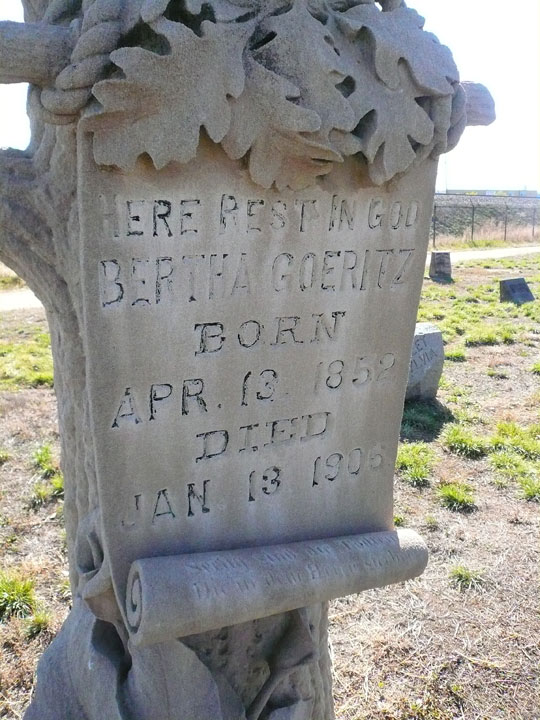Year Listed: 2008
County: Denver, Adams County
Construction Date: 1876
Threat When Listed: Lack of Maintenance
Status: ALERT
 Incorporated in 1876, Riverside Cemetery is the oldest operating cemetery in Colorado. Landscape engineer Harvey C. Lowrie created a park-like setting with dense trees, lush grasses, and a central rose garden. Listed on the National Register of Historic Places, the 77 acre site contains a wealth of unique monuments, including Lester Drake’s log cabin replica and the nation’s largest collection of zinc monuments. The administration building, constructed in 1903, was designed by notable Denver architect Frank Edbrooke. Those buried in Riverside read like a “who’s who” of Colorado history: Augusta Tabor, Barney and Julia Ford, Silas Soule, and all four territorial governors – John Evans, A. Cameron Hunt, Samuel H. Elbert, and John L. Routt. Not only is it one of the oldest cemeteries in the state, but at the turn of the 20th century, most pioneer graves from other city cemeteries were relocated to Riverside.
Incorporated in 1876, Riverside Cemetery is the oldest operating cemetery in Colorado. Landscape engineer Harvey C. Lowrie created a park-like setting with dense trees, lush grasses, and a central rose garden. Listed on the National Register of Historic Places, the 77 acre site contains a wealth of unique monuments, including Lester Drake’s log cabin replica and the nation’s largest collection of zinc monuments. The administration building, constructed in 1903, was designed by notable Denver architect Frank Edbrooke. Those buried in Riverside read like a “who’s who” of Colorado history: Augusta Tabor, Barney and Julia Ford, Silas Soule, and all four territorial governors – John Evans, A. Cameron Hunt, Samuel H. Elbert, and John L. Routt. Not only is it one of the oldest cemeteries in the state, but at the turn of the 20th century, most pioneer graves from other city cemeteries were relocated to Riverside.
Riverside is operated and owned by the Fairmount Cemetery Company, which also owns and operates Fairmount Cemetery. Unlike Fairmount, Riverside was not started with an endowment for continued care, and its water rights were based on a gentleman’s agreement from the 1890s. In the 1970s, the water rights changed hands, and the new owner was not willing to honor the agreement. Since the loss of their court battle to retain the water rights, the cemetery has been sporadically watered due to extremely high water costs.
Throughout its lifetime, the one constant at Riverside has been the changing landscape; the earliest improvements were made by the families themselves or if they had the means, they hired someone to do it for them. Others left their plots as they were, pure prairie. Landscaped plots died out if the family moved or passed on; a common occurrence in old cemeteries without endowments.
Like many historic sites in Colorado, during the 20th century Riverside was planted with non-native plants. In 2008, the Fiarmount Heritage Foundation, stewards for the preservation of Riverside, launched a plan to develop an environmentally sustainable landscape in partnership with Riverside families, horticulturists, preservationists, universities, civic groups, and concerned citizens. Under the leadership and guidance of the Fairmount Heritage Foundation a sustainable landscaping has been planted that incorporates native plantings that do not require heavy watering. Volunteers have been documenting, assessing and preserving the Riverside monuments with the help of State Historical Fund grants.
There has been little to no discussion on riverside recently. The original threat has been mitigated by the site has requested to remain listed in case of development pressures. A recent RTD proposal to relocate the cemetery entrance is a continued threat to the integrity of the site. Adequate maintenance continues to be a concern. The site is progressing towards a save, though there is always the possibility that the land could be taken for future development. Stronger communication between the FHA, CPI, and the Colorado Cemetery association are needed. As of April 2020, plans to submit a grant for work needing done to the chapel have been placed on hold.




